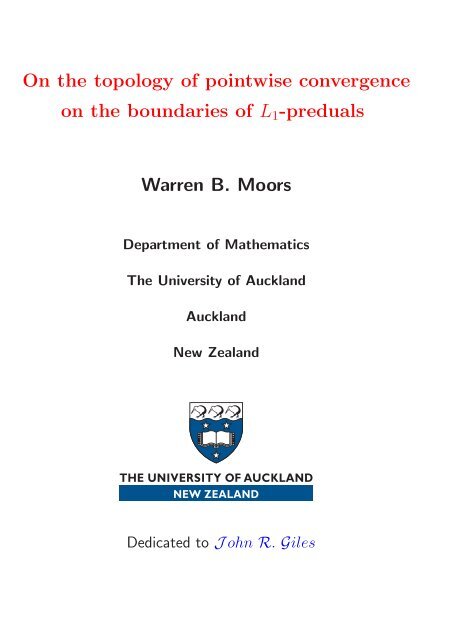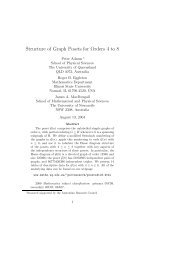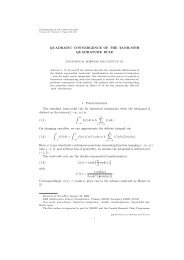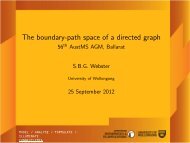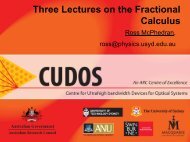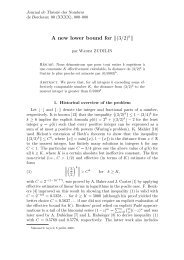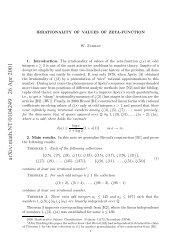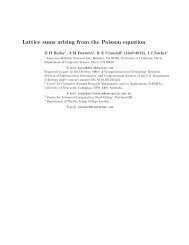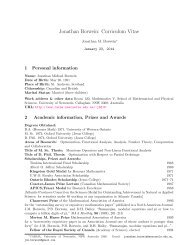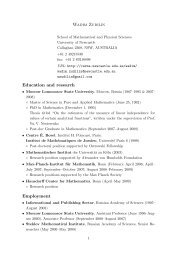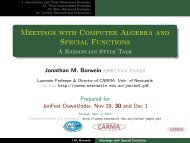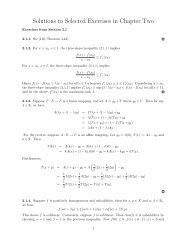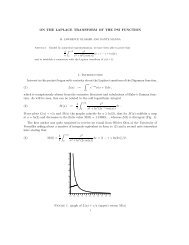On the topology of pointwise convergence on the ... - CARMA
On the topology of pointwise convergence on the ... - CARMA
On the topology of pointwise convergence on the ... - CARMA
You also want an ePaper? Increase the reach of your titles
YUMPU automatically turns print PDFs into web optimized ePapers that Google loves.
<str<strong>on</strong>g>On</str<strong>on</strong>g> <str<strong>on</strong>g>the</str<strong>on</strong>g> <str<strong>on</strong>g>topology</str<strong>on</strong>g> <str<strong>on</strong>g>of</str<strong>on</strong>g> <str<strong>on</strong>g>pointwise</str<strong>on</strong>g> <str<strong>on</strong>g>c<strong>on</strong>vergence</str<strong>on</strong>g><strong>on</strong> <str<strong>on</strong>g>the</str<strong>on</strong>g> boundaries <str<strong>on</strong>g>of</str<strong>on</strong>g> L 1 -predualsWarren B. MoorsDepartment <str<strong>on</strong>g>of</str<strong>on</strong>g> Ma<str<strong>on</strong>g>the</str<strong>on</strong>g>maticsThe University <str<strong>on</strong>g>of</str<strong>on</strong>g> AucklandAucklandNew ZealandDedicated to J ohn R. Giles
Introducti<strong>on</strong>We shall say that a Banach space (X, ‖·‖) is an L 1 -predual ifX ∗ is isometric to L 1 (µ) for some suitable measure µ. Someexamples <str<strong>on</strong>g>of</str<strong>on</strong>g> L 1 -preduals include (C(K), ‖ · ‖ ∞ ), and moregenerally, <str<strong>on</strong>g>the</str<strong>on</strong>g> space <str<strong>on</strong>g>of</str<strong>on</strong>g> c<strong>on</strong>tinuous affine functi<strong>on</strong>s <strong>on</strong> a Choquetsimplex endowed with <str<strong>on</strong>g>the</str<strong>on</strong>g> supremum norm. The o<str<strong>on</strong>g>the</str<strong>on</strong>g>rnoti<strong>on</strong> we shall c<strong>on</strong>sider in this talk is that <str<strong>on</strong>g>of</str<strong>on</strong>g> a boundary.Specifically, for a n<strong>on</strong>-trivial Banach space X over R we saythat a subset B <str<strong>on</strong>g>of</str<strong>on</strong>g> B X ∗, <str<strong>on</strong>g>the</str<strong>on</strong>g> closed unit ball <str<strong>on</strong>g>of</str<strong>on</strong>g> X ∗ , is aboundary, if for each x ∈ X <str<strong>on</strong>g>the</str<strong>on</strong>g>re exists a b ∗∈ B suchthat b ∗ (x) = ‖x‖. The prototypical example <str<strong>on</strong>g>of</str<strong>on</strong>g> a boundaryis Ext(B X ∗) - <str<strong>on</strong>g>the</str<strong>on</strong>g> set <str<strong>on</strong>g>of</str<strong>on</strong>g> all extreme points <str<strong>on</strong>g>of</str<strong>on</strong>g> B X ∗, but <str<strong>on</strong>g>the</str<strong>on</strong>g>reare many o<str<strong>on</strong>g>the</str<strong>on</strong>g>r interesting examples. In a recent paper byMoors and Reznichenko <str<strong>on</strong>g>the</str<strong>on</strong>g> authors investigated <str<strong>on</strong>g>the</str<strong>on</strong>g> <str<strong>on</strong>g>topology</str<strong>on</strong>g><strong>on</strong> a Banach space X that is generated by Ext(B X ∗) and,more generally, <str<strong>on</strong>g>the</str<strong>on</strong>g> <str<strong>on</strong>g>topology</str<strong>on</strong>g> <strong>on</strong> X generated by an arbitrary
oundary <str<strong>on</strong>g>of</str<strong>on</strong>g> X. In this talk we c<strong>on</strong>tinue this study.To be more precise we must first introduce some notati<strong>on</strong>. Fora n<strong>on</strong>empty subset Y <str<strong>on</strong>g>of</str<strong>on</strong>g> <str<strong>on</strong>g>the</str<strong>on</strong>g> dual <str<strong>on</strong>g>of</str<strong>on</strong>g> a Banach space X we shalldenote by σ(X, Y ) <str<strong>on</strong>g>the</str<strong>on</strong>g> weakest linear <str<strong>on</strong>g>topology</str<strong>on</strong>g> <strong>on</strong> X thatmakes all <str<strong>on</strong>g>the</str<strong>on</strong>g> functi<strong>on</strong>als from Y c<strong>on</strong>tinuous. In <str<strong>on</strong>g>the</str<strong>on</strong>g> paperby MR <str<strong>on</strong>g>the</str<strong>on</strong>g>y showed that “for any compact Hausdorff spaceK, any countable subset {x n : n ∈ N} <str<strong>on</strong>g>of</str<strong>on</strong>g> C(K) and anyboundary B <str<strong>on</strong>g>of</str<strong>on</strong>g> (C(K), ‖ · ‖ ∞ ), <str<strong>on</strong>g>the</str<strong>on</strong>g> closure <str<strong>on</strong>g>of</str<strong>on</strong>g> {x n : n ∈ N}with respect to <str<strong>on</strong>g>the</str<strong>on</strong>g> σ(C(K), B) <str<strong>on</strong>g>topology</str<strong>on</strong>g> is separable withrespect to <str<strong>on</strong>g>the</str<strong>on</strong>g> <str<strong>on</strong>g>topology</str<strong>on</strong>g> generated by <str<strong>on</strong>g>the</str<strong>on</strong>g> norm”.In this talk we extend this result by showing that if (X, ‖ · ‖)is an L 1 -predual, B is any boundary <str<strong>on</strong>g>of</str<strong>on</strong>g> X and {x n : n ∈ N}is any subset <str<strong>on</strong>g>of</str<strong>on</strong>g> X <str<strong>on</strong>g>the</str<strong>on</strong>g>n <str<strong>on</strong>g>the</str<strong>on</strong>g> closure <str<strong>on</strong>g>of</str<strong>on</strong>g> {x n : n ∈ N} in <str<strong>on</strong>g>the</str<strong>on</strong>g>σ(X, B) <str<strong>on</strong>g>topology</str<strong>on</strong>g> is separable with respect to <str<strong>on</strong>g>the</str<strong>on</strong>g> <str<strong>on</strong>g>topology</str<strong>on</strong>g>generated by <str<strong>on</strong>g>the</str<strong>on</strong>g> norm whenever Ext(B X ∗) is weak ∗ Lindelöf.
Preliminary ResultsLet X be a topological space and let F be a family <str<strong>on</strong>g>of</str<strong>on</strong>g> n<strong>on</strong>empty,closed and separable subsets <str<strong>on</strong>g>of</str<strong>on</strong>g> X. Then F is rich if <str<strong>on</strong>g>the</str<strong>on</strong>g> followingtwo c<strong>on</strong>diti<strong>on</strong>s are fulfilled:(i) for every separable subspace Y <str<strong>on</strong>g>of</str<strong>on</strong>g> X, <str<strong>on</strong>g>the</str<strong>on</strong>g>re exists aZ ∈ F such that Y ⊆ Z;(ii) for every increasing sequence (Z n : n ∈ N) in F,⋃n∈N Z n ∈ F.For any topological space X, <str<strong>on</strong>g>the</str<strong>on</strong>g> collecti<strong>on</strong> <str<strong>on</strong>g>of</str<strong>on</strong>g> all rich families<str<strong>on</strong>g>of</str<strong>on</strong>g> subsets forms a partially ordered set, under <str<strong>on</strong>g>the</str<strong>on</strong>g> binary relati<strong>on</strong><str<strong>on</strong>g>of</str<strong>on</strong>g> set inclusi<strong>on</strong>. This partially ordered set has a greatestelement, namely,G X := {S ∈ 2 X : S is a closed and separable subset <str<strong>on</strong>g>of</str<strong>on</strong>g> X}.<str<strong>on</strong>g>On</str<strong>on</strong>g> <str<strong>on</strong>g>the</str<strong>on</strong>g> o<str<strong>on</strong>g>the</str<strong>on</strong>g>r hand, if X is a separable space, <str<strong>on</strong>g>the</str<strong>on</strong>g>n <str<strong>on</strong>g>the</str<strong>on</strong>g> partiallyordered set has a least element, namely, G ∅ := {X}.
The rais<strong>on</strong> d’être for rich families is revealed next.Propositi<strong>on</strong> 1 Suppose that X is a topological space. If{F n : n ∈ N} are rich families <str<strong>on</strong>g>of</str<strong>on</strong>g> X <str<strong>on</strong>g>the</str<strong>on</strong>g>n so is ⋂ n∈N F n.Throughout this talk we will be primarily working with Banachspaces and so a natural class <str<strong>on</strong>g>of</str<strong>on</strong>g> rich families, given a Banachspace X, is <str<strong>on</strong>g>the</str<strong>on</strong>g> family <str<strong>on</strong>g>of</str<strong>on</strong>g> all closed separable linear subspaces<str<strong>on</strong>g>of</str<strong>on</strong>g> X, which we denote by S X . There are however many o<str<strong>on</strong>g>the</str<strong>on</strong>g>rinteresting examples <str<strong>on</strong>g>of</str<strong>on</strong>g> rich families.Theorem 1 Let X be an L 1 -predual. Then <str<strong>on</strong>g>the</str<strong>on</strong>g> set <str<strong>on</strong>g>of</str<strong>on</strong>g> allclosed separable linear subspaces <str<strong>on</strong>g>of</str<strong>on</strong>g> X that are <str<strong>on</strong>g>the</str<strong>on</strong>g>mselvesL 1 -preduals forms a rich family.
Lemma 1 Let Y be a closed separable linear subspace <str<strong>on</strong>g>of</str<strong>on</strong>g> aBanach space X and suppose that L ⊆ Ext(B X ∗) is weak ∗Lindelöf. Then <str<strong>on</strong>g>the</str<strong>on</strong>g>re exists a closed separable linear subspaceZ <str<strong>on</strong>g>of</str<strong>on</strong>g> X, c<strong>on</strong>taining Y , such that for any l ∗ ∈ L and any x ∗ ,y ∗ ∈ B Z ∗ if l ∗ | Z = 1 2 (x∗ + y ∗ ) <str<strong>on</strong>g>the</str<strong>on</strong>g>n x ∗ | Y = y ∗ | Y .Using this Lemma we can obtain <str<strong>on</strong>g>the</str<strong>on</strong>g> following <str<strong>on</strong>g>the</str<strong>on</strong>g>orem.Theorem 2 Let X be a Banach space and let L ⊆ Ext(B X ∗)be a weak ∗ Lindelöf subset. Then <str<strong>on</strong>g>the</str<strong>on</strong>g> set <str<strong>on</strong>g>of</str<strong>on</strong>g> all Z in S X suchthat {l ∗ | Z : l ∗ ∈ L} ⊆ Ext(B Z ∗) forms a rich family.Pro<str<strong>on</strong>g>of</str<strong>on</strong>g>: Let L denote <str<strong>on</strong>g>the</str<strong>on</strong>g> family <str<strong>on</strong>g>of</str<strong>on</strong>g> all closed separable linearsubspaces Z <str<strong>on</strong>g>of</str<strong>on</strong>g> X such that {l ∗ | Z : l ∗ ∈ L} ⊆ Ext(B Z ∗). Weshall verify that L is a rich family <str<strong>on</strong>g>of</str<strong>on</strong>g> closed separable linearsubspaces <str<strong>on</strong>g>of</str<strong>on</strong>g> X. So first let us c<strong>on</strong>sider an arbitrary closedseparable linear subspace Y <str<strong>on</strong>g>of</str<strong>on</strong>g> X, with <str<strong>on</strong>g>the</str<strong>on</strong>g> aim <str<strong>on</strong>g>of</str<strong>on</strong>g> showingthat <str<strong>on</strong>g>the</str<strong>on</strong>g>re exists a subspace Z ∈ L such that Y ⊆ Z. We
egin by inductively applying Lemma 1 to obtain an increasingsequence (Z n : n ∈ N) <str<strong>on</strong>g>of</str<strong>on</strong>g> closed separable linear subspaces<str<strong>on</strong>g>of</str<strong>on</strong>g> X such that: Y ⊆ Z 1 and for any l ∗ ∈ L and any x ∗ , y ∗ ∈B Z∗n+1if l ∗ | Zn+1 = 1 2 (x∗ + y ∗ ) <str<strong>on</strong>g>the</str<strong>on</strong>g>n x ∗ | Zn = y ∗ | Zn .We now claim that if Z := ⋃ n∈N Z n <str<strong>on</strong>g>the</str<strong>on</strong>g>n l ∗ | Z ∈ Ext(B Z ∗)for each l ∗ ∈ L. To this end, suppose that l ∗ ∈ L andl ∗ | Z = 1 2 (x∗ + y ∗ ) for some x ∗ , y ∗ ∈ B Z ∗.Then for each n ∈ N,l ∗ | Zn+1 = (l ∗ | Z )| Zn+1 = 1 2 (x∗ +y ∗ )| Zn+1 = 1 2 (x∗ | Zn+1 +y ∗ | Zn+1 )and x ∗ | Zn+1 , y ∗ | Zn+1 ∈ B Z∗n+1Therefore, by c<strong>on</strong>structi<strong>on</strong>x ∗ | Zn = y ∗ | Zn . Now since ⋃ n∈N Z n is dense in Z and both x ∗and y ∗ are c<strong>on</strong>tinuous we may deduce that x ∗ = y ∗ ; which inturn implies that l ∗ | Z ∈ Ext(B Z ∗). This shows that Y ⊆ Zand Z ∈ L .To complete this pro<str<strong>on</strong>g>of</str<strong>on</strong>g> we must verify that for each increasingsequence <str<strong>on</strong>g>of</str<strong>on</strong>g> closed separable subspaces (Z n : n ∈ N) in
L , ⋃ n∈N Z n ∈ L . This however, follows easily from <str<strong>on</strong>g>the</str<strong>on</strong>g>definiti<strong>on</strong> <str<strong>on</strong>g>of</str<strong>on</strong>g> <str<strong>on</strong>g>the</str<strong>on</strong>g> family L .❦ ✂✁Let X be a normed linear space. Then we say that an elementx ∗ ∈ B X ∗ is weak ∗ exposed if <str<strong>on</strong>g>the</str<strong>on</strong>g>re exists an element x ∈ Xsuch that y ∗ (x) < x ∗ (x) for all y ∗∈ B X ∗ \ {x ∗ }. It isnot difficult to show that if Exp(B X ∗) denotes <str<strong>on</strong>g>the</str<strong>on</strong>g> set <str<strong>on</strong>g>of</str<strong>on</strong>g> allweak ∗ exposed points <str<strong>on</strong>g>of</str<strong>on</strong>g> B X ∗ <str<strong>on</strong>g>the</str<strong>on</strong>g>n Exp(B X ∗) ⊆ Ext(B X ∗).However, if X is a separable L 1 -predual <str<strong>on</strong>g>the</str<strong>on</strong>g>n <str<strong>on</strong>g>the</str<strong>on</strong>g> relati<strong>on</strong>shipbetween Exp(B X ∗) and Ext(B X ∗) is much closer.Lemma 2 If X is a separable L 1 -predual, <str<strong>on</strong>g>the</str<strong>on</strong>g>n Exp(B X ∗) =Ext(B X ∗).Let us also pause for a moment to recall that if B is anyboundary <str<strong>on</strong>g>of</str<strong>on</strong>g> a Banach space X <str<strong>on</strong>g>the</str<strong>on</strong>g>nExp(B X ∗) ⊆ B ∩ Ext(B X ∗) ⊆ Ext(B X ∗) ⊆ B weak∗ .
The fact that Ext(B X ∗) ⊆ B weak∗ follows from Milman’s<str<strong>on</strong>g>the</str<strong>on</strong>g>orem and <str<strong>on</strong>g>the</str<strong>on</strong>g> fact that B X ∗ = co weak∗ (B); which in turnfollows from a separati<strong>on</strong> argument.Let us also take this opportunity to observe that if B X denotes<str<strong>on</strong>g>the</str<strong>on</strong>g> closed unit ball in X <str<strong>on</strong>g>the</str<strong>on</strong>g>n B X is closed in <str<strong>on</strong>g>the</str<strong>on</strong>g> σ(X, B)<str<strong>on</strong>g>topology</str<strong>on</strong>g> for any boundary B <str<strong>on</strong>g>of</str<strong>on</strong>g> X.Finally, let us end this part <str<strong>on</strong>g>of</str<strong>on</strong>g> <str<strong>on</strong>g>the</str<strong>on</strong>g> talk with <strong>on</strong>e more simpleobservati<strong>on</strong> that will turn out to be useful in our laterendeavours.Propositi<strong>on</strong> 2 Suppose that Y is a linear subspace <str<strong>on</strong>g>of</str<strong>on</strong>g> a Banachspace (X, ‖ · ‖) and B is any boundary for X. Then foreach e ∗ ∈ Exp(B Y ∗) <str<strong>on</strong>g>the</str<strong>on</strong>g>re exists b ∗ ∈ B such that e ∗ = b ∗ | Y .Pro<str<strong>on</strong>g>of</str<strong>on</strong>g>: Suppose that e ∗ ∈ Exp(B Y ∗) <str<strong>on</strong>g>the</str<strong>on</strong>g>n <str<strong>on</strong>g>the</str<strong>on</strong>g>re exists anx ∈ Y such that y ∗ (x) < e ∗ (x) for each y ∗ ∈ B Y ∗ \ {e ∗ }.By <str<strong>on</strong>g>the</str<strong>on</strong>g> fact that B is a boundary <str<strong>on</strong>g>of</str<strong>on</strong>g> (X, ‖ · ‖) <str<strong>on</strong>g>the</str<strong>on</strong>g>re exists a
∗ ∈ B such that b ∗ (x) = ‖x‖ ≠ 0. Then for any y ∗ ∈ B Y ∗we havey ∗ (x) ≤ |y ∗ (x)| ≤ ‖y ∗ ‖‖x‖ ≤ ‖x‖ = b ∗ (x) = (b ∗ | Y )(x).In particular, e ∗ (x) ≤ b ∗ | Y (x). Since b ∗ | Y ∈ B Y ∗ andy ∗ (x) < e ∗ (x) for all y ∗ ∈ B Y ∗ \ {e ∗ }, it must be <str<strong>on</strong>g>the</str<strong>on</strong>g> casethat e ∗ = b ∗ | Y .❦ ✂✁The Main ResultsTheorem 3 Let B be any boundary for a Banach space Xthat is an L 1 -predual and suppose that {x n : n ∈ N} ⊆ X,<str<strong>on</strong>g>the</str<strong>on</strong>g>n {x n : n ∈ N} σ(X,B) ⊆ {x n : n ∈ N} σ(X,Ext(B X ∗)) .Pro<str<strong>on</strong>g>of</str<strong>on</strong>g>: In order to obtain a c<strong>on</strong>tradicti<strong>on</strong> let us suppose that{x n : n ∈ N} σ(X,B) ⊈ {x n : n ∈ N} σ(X,Ext(B X ∗)) .Choose x ∈ {x n : n ∈ N} σ(X,B) \ {x n : n ∈ N} σ(X,Ext(B X ∗)) .Then <str<strong>on</strong>g>the</str<strong>on</strong>g>re exists a finite set {e ∗ 1, e ∗ 2, . . .,e ∗ m} ⊆ Ext(B X ∗)
for all j ∈ N and all 1 ≤ k ≤ m. Thus,⋂{y ∈ X : |b ∗ k(x) − b ∗ k(y)| < ε} ∩ {x n : n ∈ N} = ∅.1≤k≤mThis c<strong>on</strong>tradicts <str<strong>on</strong>g>the</str<strong>on</strong>g> fact that x ∈ {x n : n ∈ N} σ(X,B) ; whichcompletes <str<strong>on</strong>g>the</str<strong>on</strong>g> pro<str<strong>on</strong>g>of</str<strong>on</strong>g>.❦ ✂✁Corollary 1 Let B be any boundary for a Banach spaceX that is an L 1 -predual. Then every relatively countablyσ(X, B)-compact subset is relatively countably σ(X, Ext(B X ∗))-compact. In particular, every norm bounded, relatively countablyσ(X, B)-compact subset is relatively weakly compact.Pro<str<strong>on</strong>g>of</str<strong>on</strong>g>: Suppose that a n<strong>on</strong>empty set C ⊆ X is relativelycountably σ(X, B)-compact. Let {c n : n ∈ N} be any sequencein C <str<strong>on</strong>g>the</str<strong>on</strong>g>n by Theorem 3∅ ≠ ⋂ {c k : k ≥ n} σ(X,B) ⊆ ⋂ {c k : k ≥ n} σ(X,Ext(B X ∗))n∈Nn∈N
Hence C is relatively countably σ(X, Ext(B X ∗))-compact. In<str<strong>on</strong>g>the</str<strong>on</strong>g> case when C is also norm bounded <str<strong>on</strong>g>the</str<strong>on</strong>g> result follows froman earlier result <str<strong>on</strong>g>of</str<strong>on</strong>g> Kharana.❦ ✂✁Recall that a network for a topological space X is a familyN <str<strong>on</strong>g>of</str<strong>on</strong>g> subsets <str<strong>on</strong>g>of</str<strong>on</strong>g> X such that for any point x ∈ X andany open neighbourhood U <str<strong>on</strong>g>of</str<strong>on</strong>g> x <str<strong>on</strong>g>the</str<strong>on</strong>g>re is an N ∈ N suchthat x ∈ N ⊆ U, and a topological space X is said tobe ℵ 0 -m<strong>on</strong>olithic if <str<strong>on</strong>g>the</str<strong>on</strong>g> closure <str<strong>on</strong>g>of</str<strong>on</strong>g> every countable set has acountable network.Corollary 2 Let B be any boundary for a Banach space Xthat is an L 1 -predual and suppose that {x n : n ∈ N} ⊆ X.Then {x n : n ∈ N} σ(X,B) is norm separable whenever X isℵ 0 -m<strong>on</strong>olithic in <str<strong>on</strong>g>the</str<strong>on</strong>g> σ(X, Ext(B X ∗)) <str<strong>on</strong>g>topology</str<strong>on</strong>g>. In particular,{x n : n ∈ N} σ(X,B) is norm separable whenever Ext(B X ∗) isweak ∗ Lindelöf.
Propositi<strong>on</strong> 3 Let B be any boundary for a Banach space Xthat is an L 1 -predual and suppose that A is a separable Bairespace. If X is ℵ 0 -m<strong>on</strong>olithic in <str<strong>on</strong>g>the</str<strong>on</strong>g> σ(X, Ext(B X ∗)) <str<strong>on</strong>g>topology</str<strong>on</strong>g><str<strong>on</strong>g>the</str<strong>on</strong>g>n for each c<strong>on</strong>tinuous mapping f : A → (X, σ(X, B))<str<strong>on</strong>g>the</str<strong>on</strong>g>re exists a dense subset D <str<strong>on</strong>g>of</str<strong>on</strong>g> A such that f is c<strong>on</strong>tinuouswith respect to <str<strong>on</strong>g>the</str<strong>on</strong>g> norm <str<strong>on</strong>g>topology</str<strong>on</strong>g> <strong>on</strong> X at each point <str<strong>on</strong>g>of</str<strong>on</strong>g> D.Pro<str<strong>on</strong>g>of</str<strong>on</strong>g>: Fix ε > 0 and c<strong>on</strong>sider <str<strong>on</strong>g>the</str<strong>on</strong>g> open set:O ε := ⋃ {U ⊆ A : U is open and ‖ · ‖ − diam[f(U)] ≤ 2ε}.We shall show that O ε is dense in A. To this end, let Wbe a n<strong>on</strong>empty open subset <str<strong>on</strong>g>of</str<strong>on</strong>g> A and let {a n : n ∈ N} be acountable dense subset <str<strong>on</strong>g>of</str<strong>on</strong>g> W. Then by c<strong>on</strong>tinuityf(W) ⊆ {f(a n ) : n ∈ N} σ(X,B) ;which is norm separable by Corollary 2. Therefore <str<strong>on</strong>g>the</str<strong>on</strong>g>re existsa countable set {x n : n ∈ N} in X such that f(W) ⊆
⋃n∈N (x n+εB X ). For each n ∈ N, let C n := f −1 (x n +εB X ).Since each x n + εB X is closed in <str<strong>on</strong>g>the</str<strong>on</strong>g> σ(X, B) <str<strong>on</strong>g>topology</str<strong>on</strong>g> eachset C n is closed in A and moreover, W ⊆ ⋃ n∈N C n. Since Wis <str<strong>on</strong>g>of</str<strong>on</strong>g> <str<strong>on</strong>g>the</str<strong>on</strong>g> sec<strong>on</strong>d Baire category in A <str<strong>on</strong>g>the</str<strong>on</strong>g>re exist a n<strong>on</strong>emptyopen set U ⊆ W and a k ∈ N such that U ⊆ C k . ThenU ⊆ O ε ∩ W and so O ε is indeed dense in A. Clearly, f is‖ · ‖-c<strong>on</strong>tinuous at each point <str<strong>on</strong>g>of</str<strong>on</strong>g> ⋂ n∈N O 1/n.❦ ✂✁Theorem 4 Suppose that A is a topological space with countabletightness that possesses a rich family F <str<strong>on</strong>g>of</str<strong>on</strong>g> Baire subspacesand suppose that X is an L 1 -predual. Then for anyboundary B <str<strong>on</strong>g>of</str<strong>on</strong>g> X and any c<strong>on</strong>tinuous functi<strong>on</strong> f : A →(X, σ(X, B)) <str<strong>on</strong>g>the</str<strong>on</strong>g>re exists a dense subset D <str<strong>on</strong>g>of</str<strong>on</strong>g> A such that fis c<strong>on</strong>tinuous with respect to <str<strong>on</strong>g>the</str<strong>on</strong>g> norm <str<strong>on</strong>g>topology</str<strong>on</strong>g> <strong>on</strong> X at eachpoint <str<strong>on</strong>g>of</str<strong>on</strong>g> D provided X is ℵ 0 -m<strong>on</strong>olithic in <str<strong>on</strong>g>the</str<strong>on</strong>g> σ(X, Ext(B X ∗))<str<strong>on</strong>g>topology</str<strong>on</strong>g>.
Pro<str<strong>on</strong>g>of</str<strong>on</strong>g>: In order to obtain a c<strong>on</strong>tradicti<strong>on</strong> let us supposethat f does not have a dense set <str<strong>on</strong>g>of</str<strong>on</strong>g> points <str<strong>on</strong>g>of</str<strong>on</strong>g> c<strong>on</strong>tinuity withrespect to <str<strong>on</strong>g>the</str<strong>on</strong>g> norm <str<strong>on</strong>g>topology</str<strong>on</strong>g> <strong>on</strong> X. Since A is a Baire spacethis implies that for some ε > 0 <str<strong>on</strong>g>the</str<strong>on</strong>g> open set:O ε := ⋃ {U ⊆ A : U is open and ‖ · ‖-diam[f(U)] ≤ 2ε}is not dense in A. That is, <str<strong>on</strong>g>the</str<strong>on</strong>g>re exists a n<strong>on</strong>empty opensubset W <str<strong>on</strong>g>of</str<strong>on</strong>g> A such that W ∩ O ε = ∅. For each x ∈ A, letF x := {y ∈ A : ‖f(y) − f(x)‖ > ε}.Then x ∈ F x for each x ∈ W. Moreover, since A has countabletightness, for each x ∈ W, <str<strong>on</strong>g>the</str<strong>on</strong>g>re exists a countablesubset C x <str<strong>on</strong>g>of</str<strong>on</strong>g> F x such that x ∈ C x .
Next, we inductively define an increasing sequence <str<strong>on</strong>g>of</str<strong>on</strong>g> separablesubspaces (F n : n ∈ N) <str<strong>on</strong>g>of</str<strong>on</strong>g> A and countable sets(D n : n ∈ N) in A such that:(i) W ∩ F 1 ≠ ∅;(ii) ⋃ {C x : x ∈ D n ∩ W } ∪ F n ⊆ F n+1 ∈ F for all n ∈ N,where D n is any countable dense subset <str<strong>on</strong>g>of</str<strong>on</strong>g> F n .Note that since <str<strong>on</strong>g>the</str<strong>on</strong>g> family F is rich this c<strong>on</strong>structi<strong>on</strong> is possible.Let F := ⋃ n∈N F n and D := ⋃ n∈N D n. Then D = F ∈ Fand ‖ · ‖-diam[f(U)] ≥ ε for every n<strong>on</strong>empty open subsetU <str<strong>on</strong>g>of</str<strong>on</strong>g> F ∩ W. Therefore, f| F has no points <str<strong>on</strong>g>of</str<strong>on</strong>g> c<strong>on</strong>tinuityin F ∩ W with respect to <str<strong>on</strong>g>the</str<strong>on</strong>g> ‖ · ‖-<str<strong>on</strong>g>topology</str<strong>on</strong>g>. This however,c<strong>on</strong>tradicts Propositi<strong>on</strong> 3.❦ ✂✁
Corollary 3 Suppose that A is a topological space with countabletightness that possesses a rich family <str<strong>on</strong>g>of</str<strong>on</strong>g> Baire subspacesand suppose that K is a compact Hausdorff space. Then forany boundary <str<strong>on</strong>g>of</str<strong>on</strong>g> (C(K), ‖ · ‖ ∞ ) and any c<strong>on</strong>tinuous functi<strong>on</strong>f : A → (C(K), σ(C(K), B)) <str<strong>on</strong>g>the</str<strong>on</strong>g>re exists a dense subset D<str<strong>on</strong>g>of</str<strong>on</strong>g> A such that f is c<strong>on</strong>tinuous with respect to <str<strong>on</strong>g>the</str<strong>on</strong>g> ‖ · ‖ ∞ -<str<strong>on</strong>g>topology</str<strong>on</strong>g> at each point <str<strong>on</strong>g>of</str<strong>on</strong>g> D.——————————– The End ——————————–


